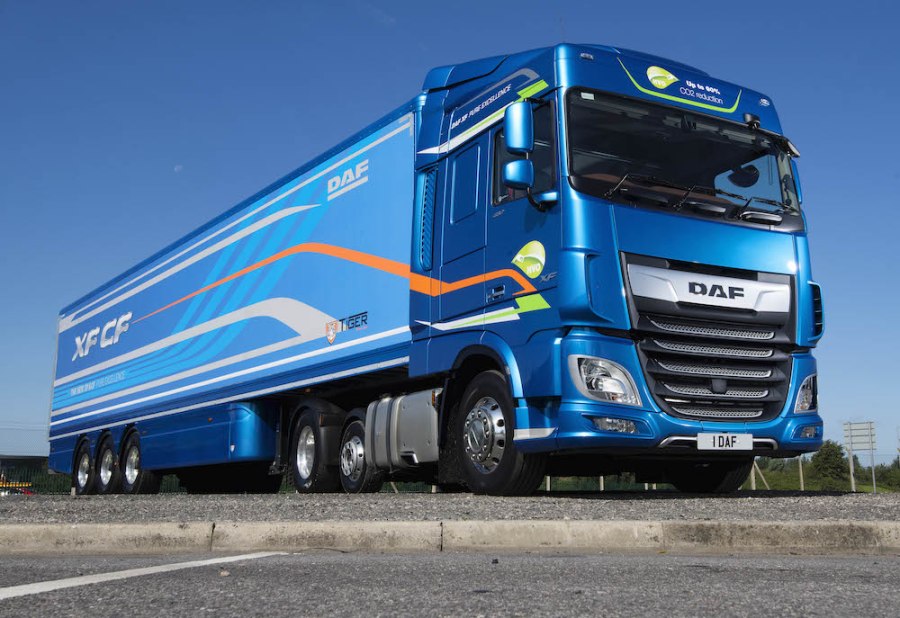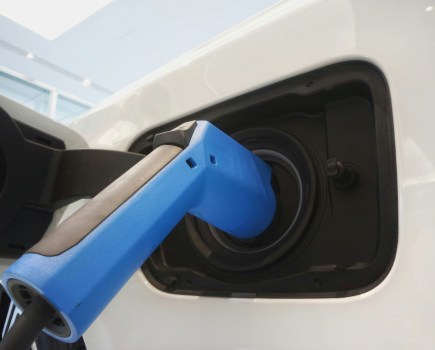DAF’s lightweight FTP chassis puts its emphasis squarely on maximum payload. The 6×2 set-up with lightweight pusher axle has been carefully pared down to help hauliers achieve the most bang for their buck – so it’s not surprising the configuration has found prominence on more than a few big-name fleets.
Back in May, Turners of Soham broke DAF records by putting its 800th FTP on the road. The Cambridgeshire-based firm is the one of the biggest FTP operators in the world, reckons DAF, and the chassis has been described as “probably the best lightweight truck ever” by Turner’s group fleet engineer, Tim King. Strong words indeed.
FTP was a relatively new concept when it first launched. With a smaller 17.5 inch wheel on the second axle that only drops when laden, it provides up to 480 kg of extra payload compared to an XF FTG 6×2 twin-steer tractor, plus enables larger fuel tanks to be fitted. Initially, it looked like the only main drawback was operators spec’ing FTP would have to keep an extra set of smaller tyres in the yard.
But there were some early problems. Firstly, some hauliers reported issues with axles after they were incorrectly rebuilt to take the smaller wheels by some third-party fitters. Secondly, some drivers just didn’t like the way they looked.
The first problem is now well and truly sorted, reckons DAF. “Our latest range of Euro 6 axles are a different ballgame,” the Dutch manufacturer’s product marketing manager, James Turner, tells us. These have been redesigned with a completely different structure, he explains, which has eradicated the problems experienced by some of FTP’s early adopters.
But the aesthetics issue is ongoing. A smaller wheel on the leading rear axle can rub drivers up the wrong way. It’s possible to mitigate it by fitting sideskirts, though this isn’t something DAF offers from the factory. But when you’re a cost-conscious big-fleet operator, chances are the bottom-line benefits will shout louder than driver preference.
FTP can be spec’d with engine options to suit most applications, ranging from the smaller displacement 10.8-litre MX-11 at 449 bhp and 2300 Nm maximum torque, to larger 12.9-litre MX-13 powerplants delivering 428, 483 and 530 bhp (at 2300, 2500 and 2600 Nm torque respectively).
The engines can be mated to 12- or 16-speed TraXon automated transmissions (though a 16-speed manual is still offered for those who prefer stirring the stick). Eco Fuel mode is the default shifting strategy for the auto ’boxes, which prioritises fuel economy over performance – though an Eco Performance mode can be optioned if a more balanced point between economy and drivability is preferred.
Test spec
Recently, we were offered the opportunity to take an XF480 FTP for a test drive around leafy Berkshire to see how the lightweight chassis performed. Loaded to 41 tonnes, the tractor unit was coupled to a Tiger Trailers tri-axle box and had been filled with cleaner-burning HVO (hydrotreated vegetable oils) instead of diesel, as is DAF’s current policy (see boxout for more on this ‘drop-in’ alternative fuel).
Our test truck’s configuration can’t quite be described as ‘no frills’, but it isn’t far off. There’s no sun visor, no beacons, no air horns, and not a spotlight or top light to be seen. In short, anything that could adversely affect aerodynamics had been jettisoned.
In typical press test fashion, the interior of the Space Cab had been lavished with some luxuries to make the driver’s life a bit more comfortable. An Exclusive trim level provides brown panelling and highlights, leather steering wheel, leather door covering, leather seats with arm rest and Xtra leather air passenger seat, and we had a decent sized 42-litre fridge. The lower bunk was also rocking an Xtra Comfort mattress for a better night’s sleep.
It makes for a very nice driving and living environment, though we’re aware the majority of drivers will likely find themselves with a lower-spec interior to work in (and we’d actually prefer cloth seats any day of the week). But to its credit, even DAF’s base spec is pretty comfortable and well-built in our experience.
On the road
Our drive kicked off on a sunny Monday morning at DAF’s new UK headquarters in Haddenham. Our aim was to take a decent mixed route through Berkshire, taking in rural and semi-rural A-roads, a few town centres and a bit of motorway cruising.
Rolling out of town, we picked up the A418 headed to Aylesbury. After negotiating a few roundabouts in the town centre, we took the A413 to Buckingham. It’s a good road, if a bit twisty and narrow in places, but we found the FTP handled very well indeed. It gives a comfortable and positive ride, with good feedback through the wheel. The Space Cab makes for a quiet place to work, and all-round visibility is pretty good.
This XF was fitted with Predictive Cruise Control (PCC), which uses GPS to determine the exact position of the vehicle and automatically analyse the terrain conditions for the next 1-2 kilometres. We made extensive use of it on our drive and it behaved pretty much flawlessly, making predictive gear shifts to preempt the hills we encountered along the way, staying in higher gears for longer while climbing to eek out fuel economy.
From Buckingham, we took the A422 to Bicester, where we pulled out onto the M40 for a bit of motorway work. For most of the journey we were cruising at a steady 56 mph in the midday traffic, but spotting vehicles backed up near Stokenchurch, we pulled off onto the A40 to head back to Haddenham cross country.
At one point, the A40 follows a long, sweeping and particularly narrow single-lane descent – so the perfect place to flex the muscles of the XF’s powerful MX Engine Brake. While keeping a close eye on the overhanging branches trying to push us across the boundary marker, we managed to complete the descent without having to touch the service brakes – instead, we just flicked between stages on the stalk to keep us to a safe speed. A good effort at 41 tonnes.
With nearly 12 bhp per tonne to play with, the XF coped well around this fairly sedate region of the UK and we’d have been quite happy to motor along in the FTP all day long. Which wouldn’t have been much of a problem, as our test truck was fitted with twin fuel tanks of 605- and 325 litres. Compare this to the maximum 490 litres available on the regular FTG 6×2 chassis and it’s clear FTP has serious legs for long-haul (and in fairness, the twin tanks actually make the smaller wheels look a little better overall to our eyes).
Verdict
Proving once again that DAFs make great driver’s trucks, the lightweight FTP provided a positive and comfortable ride on our test. And it’s easy to see why some of the bigger operators continue to bolster their fleets with smaller-wheeled mid-lifts – not only do they perform well, but their extra payload and boosted operating range is a powerful draw.
They may not have quite the same visual appeal as an FTG chassis, but most bean-counters will be more than happy with skewing more towards economy than aesthetics. And if drivers really don’t like it, an aftermarket sideskirt kit can help sort things out.
HVO: A clean switch?
For operators looking to move away from diesel to a cleaner alternative fuel, HVO (hydrotreated vegetable oils) is perhaps the easiest switch to make. Produced using a range of waste products from the food processing industry (cooking oils, animal fats and other waste fats) or specially harvested crops such as palm and rapeseed oil, HVO offers a raft of environmentally sound benefits – and requires no special kit on the vehicle.
“Interest in, and awareness of, HVO has grown significantly over recent months,” DAF’s marketing manager, Phil Moon, tells us. “For operators looking to reduce their greenhouse gas emissions, HVO provides a solution that can deliver an immediate 90 per cent saving with minimal operational disruption, and with none of the complexities and uncertainties associated with biomethane – which is the only other fuel that comes close in terms of well-to-wheel carbon reduction.
“There is a cost premium for HVO over fossil diesel,” Moon continues, “but unlike gaseous alternatives there is no requirement for new vehicles, refuelling infrastructure or changes to maintenance. Some environmentally focused firms already recognise a value in being green and some business sectors are facing taxes based on their CO2 emissions. Operators also appreciate that with HVO, they can revert to diesel at any time.
“There is no real problem with availability, as there are stocks in the UK with suppliers able to deliver into existing on-site diesel tanks or into a self-contained bowser, which is what we do here at DAF,” he continues (DAF currently runs is demo fleet on HVO). “The cost premium over diesel will depend on an operator’s current diesel purchases, but 8-10 ppl would be a typical budget number,” Moon concludes.
DAF Driver Challenge
DAF is currently scouring the country to find the very best drivers as part of its UK Driver Challenge. Open to drivers in Great Britain and Ireland, the competition culminates in 2020 where a single driver from an elite group of 20 finalists will be crowned the best of the best after two days of gruelling tests at the Millbrook Proving Ground.
“Make no mistake, this is a challenge in the true sense of the word,” said DAF’s marketing man, Phil Moon. “Our 20 finalists must display exemplary levels of driving skill, road awareness and a deep understanding of the transport business. The winner can rightly claim to be the best of the best – regardless of the make and model of their own vehicle.”
To find out more information, head here.
SPECIFICATION
- Model: DAF XF480 FTP 6×2 tractor unit
- Design GVW/GCW: 23,900 kg / 44,000 kg
- Chassis: 4050 mm wheelbase
- Gearbox: TraXon 12-speed automated transmission, Eco Fuel programme
- Engine: 12.9-litre MX-13 355, Euro 6, MX Engine Brake
- Max power: 483 bhp @ 1600 rpm
- Max torque: 2500 Nm @ 900-1125 rpm
- Cab: Space Cab, air suspension
- Fuel tanks: Aluminium (1x 605-litre with step, 1x 325-litre)
- AdBlue tank: 90 litres
- Additional equipment: Alcoa Dura-Bright aluminium wheels






